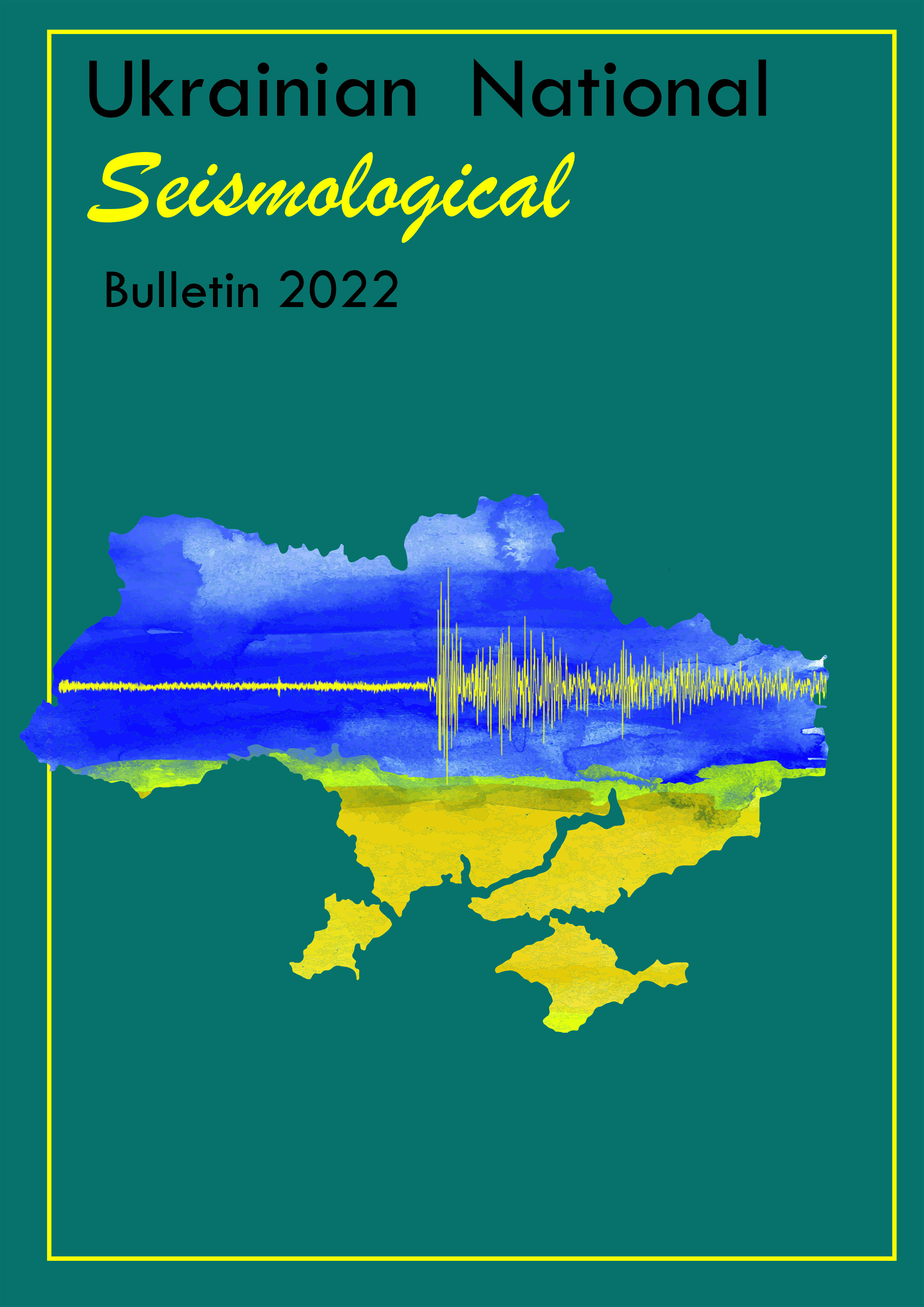Національний сейсмологічний бюлетень України за 2022 рік
DOI:
https://doi.org/10.24028/gj.v46i4.305052Ключові слова:
землетрус, сейсмологічна мережа, магнітуда, епіцентральна відстань, зона Вранча, сейсмологічний бюлетеньАнотація
Національна система сейсмічних спостережень України станом на 2022 рік мала мережу пунктів спостереження які знаходяться у відомстві Інституту геофізики імені С.І. Субботіна Національної академії наук та Головного центру спеціального контролю Державного космічного агентства України. На базі цих установ створений об’єднаний Національний центр даних, де проводиться збір, обробка та аналіз отриманих даних. Інформація надається як в оперативному режимі, так і згодом, після поглибленого аналізу у вигляді сейсмологічних бюлетенів та каталогів землетрусів.
За результатами інструментальних спостережень у 2022 році на території України та суміжних держав відбулося 160 землетрусів, основна частина яких була приурочена до глибокофокусної зони Вранча (Румунія). Максимальна зафіксована магнітуда землетрусу – 5,4. Землетруси з території інших суміжних держав мали локальний характер та не створювали суттєвого впливу на сейсмічність території України. Найбільш потужні землетруси у межах території України було зареєстровано в Полтавській області 06.07.2022 року та 03.10.2022 року. Ці землетруси мали магнітуду 3,4 та при глибині гіпоцентру 10 км спричинили струшування в епіцентральній області з інтенсивністю до 2 балів. Крім того 21.01.2022 року було зареєстровано землетрус в районі Кривого Рогу. Цей землетрус мав магнітуду 3,3, але через меншу глибину гіпоцентру (h = 5 км) спричинив відчутні струшування в районі епіцентру з інтенсивністю до 3 балів.
На території України більшість епіцентрів зареєстрованих землетрусів знаходиться в межах Волино-Поділля, Дніпровсько-Донецької западини та Передкарпатського прогину.
Сейсмологічний бюлетень України включає детальну інформацію про всі сейсмічні події, що відбулися у 2022 році на територіях України та сусідніх країн.
Повну інформація по кожному землетрусу із Каталогу землетрусів за 2022 рік у повному обсязі приведено у pdf файлі одноіменної статті на сайті Геофізичного журналу.
Посилання
Andrushchenko, Y., Osadchy, V.I., Liashchuk, О.I., & Kornienko, I.V. (2020). Instrumental Observations at the Rivne NPP Permanent Seismic Monitoring Network. Geofizicheskiy Zhurnal, 42(4), 133—141. https://doi.org/10.24028/gzh. 0203-3100.v42i4.2020.210677 (in Ukrainian).
Borodulin, V.A., & Baisarovych, M.N. (1992). Model of the lithosphere of the Ukrainian shield based on OGT ma-terials. Geofizicheskiy Zhurnal, 14(4), 57—66 (in Russian).
Verbytskyi, S.T., & Verbytskyi, Yu.T. (2011). Current state and prospects of development studies seismological in the Carpathian region of Ukraine. Geodynamics, (2), 35—37. https://doi.org/10.23939/jgd2011.02.035 (in Ukrainian).
Ganiev, O.Z., Amashukeli, T.A., Farfuliak, L.V., & Petrenko, K.V. (2021). Organization of the stationary seismo-logical observations point. Geofizicheskiy Zhurnal, 43(5), 232―240. https://doi.org/10.24028/gzh.v43i5.244085 (in Ukrainian).
Kendzera, O., Verbytskyi, T., Verbytskyi, S., & Verbytskyi, Y. (1998). Digital seismograph for regional observations and results of its tests. Geodynamics, (1), 120―126 (in Ukrainian).
Kutas, V.V., Andrushchenko, Yu.A., Omelchenko, V.D., Lyashchuk, A.I., & Kalitova, I.A. (2015). Earthquakes in the Dnieper-Donets aulakogen. Geofizicheskiy Zhurnal, 37(5), 143―151. https://doi.org/10.24028/gzh.0203-3100.v37i5.
111156 (in Russian).
Mikhaylik, I.Yu., Ganiev, A.Z., Petrenko, K.V., & Amashukeli, T.A. (2019). Equipment of seismic station IRIS KIEV and software interface for access to seismological data. Geofizicheskiy Zhurnal, 41(6), 203¾212. https://doi.org/10.24028/gzh.0203-3100.v41i6.2019.190077 (in Russian).
Pygulevskyi, P.G., Kendzera, O.V., Shcherbina, S.V., Verbytskyi, S.T., Shumlyanska, L.A., Kalinichenko, O.O., Hurova, I.Yu., & Ilienko, V.A. (2017). The nature of the Kryvyi Rih earthquake of July 29, 2017. Geological and mineralogical bulletin of the Kryvyi Rih National University, (1), 92—104 (in Ukrainian).
Kruglov, S.S., & Gurskyi, D.S. (Eds.). (2007). Tectonic map of Ukraine. 1:1000000. Kyiv: UkrDGRI (in Ukrainian).
Bratt, S.R., & Nagy, W. (1991). The LocSAT Program. Science Applications International Corporation, San Diego.
Ganiev, O.Z., Amashukeli, T.A., Petrenko, K.V., Farfuliak, L.V., Gurova, I.Yu., & Kalitova, I.A. (2021). Seismic monitoring of the territory of Ukraine due to IRIS KIEV station data. European Association of Geoscientists & Engineers. Conference Proceedings, Geoinformatics, May 2021 (pp. 1—6). https://doi.org/10.3997/2214-4609.20215521066.
Main Center of Special Monitoring. (2010). Seismic Network Main Center of Special Monitoring [Data set]. Inter-national Federation of Digital Seismograph Networks. https://doi.org/10.7914/SN/UD.
Mărmureanu, A., Ionescu, C., Grecu, B., Toma-Danila, D., Tiganescu, A., Dragomir, C.S., Toa¬der, V.E., Craifa-leanu, I.G., Neagoe, C., Mei, V., Liashchuk, O., & Dimitrova, L. (2021). From
national to transnational seismic monito¬ring products and services in the Republic of Bul¬garia, Republic of Mol-dova, Romania, and Ukraine. Seismological Research Letters, (3), 1703―2021. https://doi.org/10.1785/ 0220200393.

##submission.downloads##
Опубліковано
Як цитувати
Номер
Розділ
Ліцензія
Авторське право (c) 2024 Юрий Андрущенко

Ця робота ліцензується відповідно до Creative Commons Attribution-NonCommercial-ShareAlike 4.0 International License.
1. Автори зберігають за собою авторські права на роботу і передають журналу право першої публікації разом з роботою, одночасно ліцензуючи її на умовах Creative Commons Attribution License, яка дозволяє іншим поширювати дану роботу з обов'язковим зазначенням авторства даної роботи і посиланням на оригінальну публікацію в цьому журналі .
2. Автори зберігають право укладати окремі, додаткові контрактні угоди на не ексклюзивне поширення версії роботи, опублікованої цим журналом (наприклад, розмістити її в університетському сховищі або опублікувати її в книзі), з посиланням на оригінальну публікацію в цьому журналі.
3. Авторам дозволяється розміщувати їх роботу в мережі Інтернет (наприклад, в університетському сховище або на їх персональному веб-сайті) до і під час процесу розгляду її даними журналом, так як це може привести до продуктивної обговоренню, а також до більшої кількості посилань на дану опубліковану роботу (Дивись The Effect of Open Access).

 Scimago Journal & Country Rank
Scimago Journal & Country Rank



